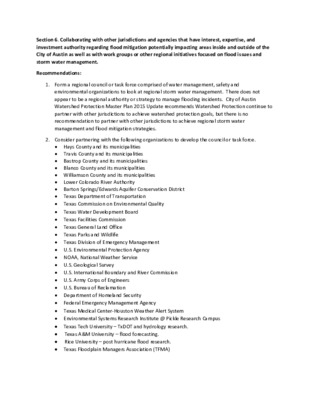Revised draft report section 6 (Collaborating with Other Jurisdictions) — original pdf
Backup

Section 6. Collaborating with other jurisdictions and agencies that have interest, expertise, and investment authority regarding flood mitigation potentially impacting areas inside and outside of the City of Austin as well as with work groups or other regional initiatives focused on flood issues and storm water management. Recommendations: 1. Form a regional council or task force comprised of water management, safety and environmental organizations to look at regional storm water management. There does not appear to be a regional authority or strategy to manage flooding incidents. City of Austin Watershed Protection Master Plan 2015 Update recommends Watershed Protection continue to partner with other jurisdictions to achieve watershed protection goals, but there is no recommendation to partner with other jurisdictions to achieve regional storm water management and flood mitigation strategies. 2. Consider partnering with the following organizations to develop the council or task force. • Hays County and its municipalities • Travis County and its municipalities • Bastrop County and its municipalities • Blanco County and its municipalities • Williamson County and its municipalities • Lower Colorado River Authority • Barton Springs/Edwards Aquifer Conservation District • Texas Department of Transportation • Texas Commission on Environmental Quality • Texas Water Development Board • Texas Facilities Commission • Texas General Land Office • Texas Parks and Wildlife • Texas Division of Emergency Management • U.S. Environmental Protection Agency • NOAA, National Weather Service • U.S. Geological Survey • U.S. International Boundary and River Commission • U.S. Army Corps of Engineers • U.S. Bureau of Reclamation • Department of Homeland Security • Federal Emergency Management Agency • Texas Medical Center-Houston Weather Alert System • Environmental Systems Research Institute @ Pickle Research Campus • Texas Tech University – TxDOT and hydrology research. • Texas A&M University – flood forecasting. • Rice University – post hurricane flood research. • Texas Floodplain Managers Association (TFMA) • American Society of Civil Engineers (ASCE)/Environmental & Water Resources Institute (EWRI)And other appropriate agencies 3. Form a Regional Flood Control District to focus on flood mitigation and stormwater management, and to fund flood mitigation programs. 4. Investigate flood management programs used by El Paso County Water Improvement District, Elephant Butte (New Mexico) Irrigation District, Tulsa, Oklahoma, City of El Paso, Texas and Louisville, Kentucky. See recommendations in Section 3. Peer Cities. 5. Encourage surrounding communities to adopt floodplain and storm drainage policies comparable to the levels of City of Austin. 6. Incorporate information from the National Water Model as needed to enhance the safety of all COA residents. 7. Coordinate with Texas A&M University for emergency veterinary services in response to flood events: http://vetmed.tamu.edu/files/vetmed/vet/texvet-0815-pages-34-35.pdf 8. Coordination with United States Geological Survey (USGS) to add more flood hardened rain and flood stage gauges for better flood forecasting in order to assist first responders during extreme rain events and for potential evacuations of Austin citizens. Investigate opportunities for grants or cost sharing with USGS to install additional flood hardened rainfall and stage gauges through the City. 9. Install, inspect, and maintain an Emergency Siren System designed to alert residents and visitors in flood prone areas. 10. Coordinate a flood warning system to include local news media, NOAA Weather Radios and local wireless phone and pager services. Ensure a contingency plan for massive power failures, lightning strikes, and damaged communication infrastructures. 11. Coordinate with each school campus located within a floodplain to ensure each has an updated Emergency Preparedness Plan in response to flooding incidents each year.